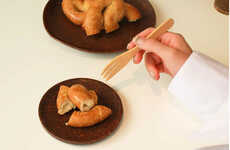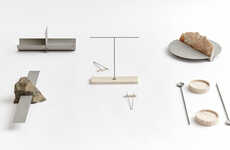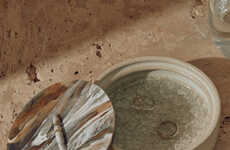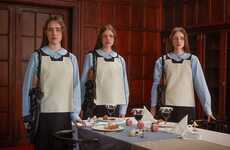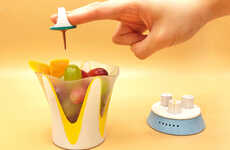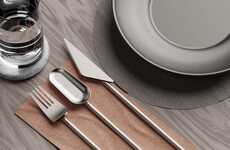
The Experimental Gastronomy Series Creates New Food Interactions
Laura McQuarrie — October 19, 2019 — Art & Design
References: steinbeisser.org & dezeen
There are hundreds of pieces of cultery and tableware designs in the Experimental Gastronomy series from Martin Kullik and Jouw Wijnsma, as the Dutch duo commissioned designers and artisans to create unconventional designs for different occasions. For the project, the artists were asked to use only natural and locally sourced materials that were found, upcycled or repurposed.
While a jelly and nasturtium sorbet is served in a foraged clay bowl that takes the place of a bicycle bell, Finnish jewelry designer Eija Mustonen created a three hand-like eating vessels in nickel silver, copper and pewter—which plays off of the idea that different foods will taste differently when eaten with utensils made of different materials. Some of the other designs include spoons that are intentionally heavy or dishware that requires the support of another object.
While a jelly and nasturtium sorbet is served in a foraged clay bowl that takes the place of a bicycle bell, Finnish jewelry designer Eija Mustonen created a three hand-like eating vessels in nickel silver, copper and pewter—which plays off of the idea that different foods will taste differently when eaten with utensils made of different materials. Some of the other designs include spoons that are intentionally heavy or dishware that requires the support of another object.
Trend Themes
1. Eco-friendly Tableware - The use of locally sourced and upcycled materials in Experimental Gastronomy creates a trend for eco-friendly tableware designs.
2. Unconventional Utensils - Artisans commissioned in the Experimental Gastronomy series to create unconventional utensils present a trend in unique and nontraditional tableware design.
3. Material-specific Eating Vessels - The idea behind Finnish jewelry designer Eija Mustonen's three hand-like eating vessels presents a trend for material-specific tableware design to enhance food interactions.
Industry Implications
1. Hospitality - The eco-friendly and unconventional designs seen in the Experimental Gastronomy series can disrupt traditional tableware used in the hospitality industry.
2. Fine Dining - Fine dining restaurants may benefit from the trend towards unique, material-specific utensils that enhance the dining experience and presentation of dishes.
3. Home Goods - The trend towards unconventional and eco-friendly tableware designs in Experimental Gastronomy can potentially disrupt traditional home goods industry by offering unique and sustainable design options.
6.7
Score
Popularity
Activity
Freshness


